
MEDIA RECLAIMER / SEPARATOR
Page 12
© 2005 CLEMCO INDUSTRIES CORP.
•
www.clemcoindustries.com
•
Manual No. 23438
•
Rev. E
8.2.2
Dust collector damper closed too far restricting
air movement in cabinet. Adjust static pressure per
Section 5.1.
8.2.3
Blocked air inlet duct in cabinet enclosure or
blast room recovery segments. Blockage in the air
intake ducts restricts incoming air and reduces air
movement. Check for blockages
8.2.4
Hole worn in flex hose between cabinet or blast
room recovery transitions and reclaimer inlet (if reverse-
pulse collector is used, also check hose between the
reclaimer outlet and dust collector inlet). Replace hoses
and route it with as few bends as possible to prevent
wear.
8.2.5
Reclaimer door open. DO NOT operate unless
door is closed.
8.2.6
Obstruction in flex hose between cabinet or
blast room recovery transitions and reclaimer inlet.
Remove hose and check for blockage.
8.2.7
Exhauster paddle wheel worn. Check wheel for
wear.
8.3
Excessively High Media Consumption
8.3.1
See Section 8.1
8.3.2
Media may be too fine or worn-out. Replace
media as necessary.
8.3.3
Using media that rapidly breaks down. If the
application allows for it, change to durable media.
8.3.4
Blast pressure too high for the media, causing
media to breakdown. Lower blast pressure if application
allows it.
8.4
Reduction in Blast Cleaning Rate
8.4.1
Low media level reducing media flow. Check
level and fill if low.
8.4.2
Incorrect metering valve adjustment. Adjust
metering valve air mixture per Section 5.4.
8.4.3
Reduced air pressure. This may be caused by a
malfunctioning regulator, a dirty filter element in moisture
separator, partially closed air supply valve, leaking air
line, or other air tools in use.
8.4.4
Blockage in media hose or blast gun. Blockage
may occur as a result of a missing debris screen or
incorrect metering valve adjustment permitting heavy
media flow. See Section 5.4.
8.4.5
Worn blast gun parts. Inspect gun body, nozzle,
and air jet. Refer to the appropriate parts list, and
replace all worn parts.
8.4.6
Worn media hose. Check hose for leaks and
soft spots. Replace worn or damaged hose.
8.4.7
Air jet in gun out of adjustment. Refer to blast
equipment instructions to check adjustment.
8.4.8
Moist media. Frequent bridges or blockage in
the area of the metering valve can be caused by
moisture. See Section 8.6.
8.5
Plugged Blast Nozzle
8.5.1
Damaged or missing debris screen. When the
filter screen is damaged or not in place, all media and
blast cleaning by-products, such as paint chips, scale
etc. pass directly into the metering valve area, blocking
the metering valve or nozzle. Check placement of the
debris screen.
8.5.2
Media mixture too rich. Adjust media metering
valve air mixture per Section 5.4.
8.6 Media
Bridging
8.6.1
Frequent bridging or blockages in the media
metering valve can be caused by damp media. Media
becomes damp by blasting parts that are slightly oily,
from moisture in the compressed air line, or from
absorption.
8.6.2
To avoid contaminating media from the
workpiece, all parts put into the cabinet should be clean
and dry. If parts are oily or greasy, degrease and dry
them prior to blasting.
8.6.3
Moist compressed air may be due to a faulty
compressor that overheats or pumps oil or moisture into
the air line, too long an air line permitting moisture to
condense on the inside, or from humidity. Drain the
moisture separator and receiver tank regularly. If the
problem persists, it may be necessary to change media
more often or install an aftercooler or air dryer.
8.6.4
Absorption: Some media tends to absorb
moisture from the air, especially fine-mesh media in high
humidity areas. Empty the media and store it in an
airtight container when cabinet is not in use.



































